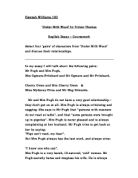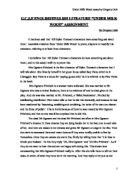The technique of alliteration is sometimes joined by assonance. Assonance also appeals to the ear and is used mostly in cataloguing.
“Arethusa, the Curlew and the skylark, Zanzibar, the Rover, the Cormorant and the Star of Wales”.
As it is the repetition of the vowel sound it is sometimes used as a substitute for end rhyme. Dylan Thomas has focused upon the fact that a list of names is more appealing then separate names.
Dylan Thomas also complements the technique of assonance with the rhyme of consonants.
One passage of interest when looking at sensual poetic technique is
“Slow clocks, quick clocks, pendulumed heart knocks, china, alarm, grandfather cuckoo, clocks…”
This passage tries to recreate the tick-tock sound of the clocks by using a repeated ‘k’ sound, which creates the image of the clocks and is aurally appealing. The repetition of the tick-tock sound may also suggest Lord Cutglass’ madness. The cataloguing is used to show the mass of clocks and noise that Lord Cutglass. Assonance and rhyme complement each other and are both aurally appealing which.
To accompany the many uses of Assonance and Alliteration Dylan Thomas also uses many metaphors and similes. Thomas uses similes throughout 'Under Milk Wood' as in “Seas barking like seals”. The simile helps the listener imagine the noise. There is alliteration in the words ‘seas’ and ‘seals’ again to create aural appeal. The word ‘barking’ is onomatopoeic which helps the listener to imagine the sound as it puts you in there creating an atmosphere. This kind of effect is important throughout the play as sound effects were rarely used. “Time passes. Listen. Time passes”. This is an oxymoron, as you cannot listen to time. This is both sensually and intellectually appealing. Dylan Thomas uses both aural and intellectual techniques to create an effective passage
“Night like a mouse with gloves”. This refers to the quietness of the night. A mouse being a quiet creature but, with gloves, a mouse is virtually silent. The comparison may also suggest that the night is mischievous as mice can be portrayed. The night can also be seen as mischievous, because it is when most sneaky, illegal, mischievous things happen.
“Night flying like black flour”. Another very ingenious use of a simile. The word ‘flying’ is used to suggest time passing quickly. There is alliteration in the words ‘flying’ and ‘flour’ to create aural appeal. Dylan has used the word ‘black’ for surprise value, as we do not expect flour to be black. The simile also suggests that the darkness floats like a dense suspended cloud; like a cloud of flour scattered accidentally by hand.
“The houses are as blind as moles” this is an example of a simile and is widely used by poets and writer’s to recreate a sense of feeling. “The houses are blind” perhaps Dylan Thomas is playing with the listener as this is almost a pun, is Thomas talking about blind (cannot see) or a blind. Houses have windows and many windows have blinds, when you close a blind upon a window you could actually be making the house blind. This is indeed like closing the eyes of a house. Although moles see fine tonight in the snouting, velvet dingles. This is another example of a transferred epithet.
“Evans the Death, the undertaker,” This transferred epithet is used again create aural appeal. It may also suggest he is more like death than an undertaker.
Another transferred epithet is the “jolly rogered sea” the sea isn’t jolly rogered but pirate ships are. There are other metaphors and similes in the play such as “Sea’s barking like seals” this description adds to the atmosphere and appeals to the ear which is poetic as it is pleasing to hear. “And the afternoon buzzes like bees” Dylan Thomas has described very well something simple and regular, the afternoon, he says it is like bees buzzing this describes to things the sound of buzzing could be the sound of a hundred voices chatting in the town or he could be describing the movement of the town on that particular afternoon.
“For (Eli Jenkins) the town is a green sermon on the innocence of man”. When Eli Jenkins looks at Llareggub he sees an epitome, a perfect place, a teacher, a preacher. It is a green sermon of nature and life. Perhaps Eli Jenkins is thinking of mans true innocence, the ‘Garden of Eden’ as Eli Jenkins is a member of the clergy, this is very possible. Mary Anne Sailors would agree “for Mary Anne Sailors, who knows there is a heaven on earth”, but of course for comical effect there is a person who is a complete contrary and believes that Llareggub is a terrible sinner filled place, none other then Jack Black who is forever shouting “Ach Y Fi” at the sinners in Llareggub.
To contrast Dylan Thomas’ usual poetic style he writes in a factual way with as little use of description and aural appeal as possible, this is where Dylan Thomas plays the part of a ‘Guidebook’ there is very little description bar one use of a very plain metaphor “is a backwater of life”. Dylan Thomas use this simple description to prove that the guidebook writer is being very dismissive as if to say not to bother to the passing tourists he says the town is very placid, still. But of course we no differently the town is mad and perhaps deranged. Dylan Thomas uses the Guidebook as an outsider’s opinion. This new style is full of facts whereas Dylan Thomas preferred style has literally none. Dylan Thomas uses the voice of the guidebook to show that he can imitate the other styles and really shows his mastery of English.
“Less than five hundred souls inhabit the three quaint streets and the few narrow by-lanes and scattered watering-place which may, indeed, be called a ‘backwater of life”…’
This shows Dylan’s mastery of different writing techniques, as he writes in a factual way using lytosis, past tense and statistics to present the ‘Bugger all’ view of Llareggub. He uses this effect to produce a ‘calm before the storm’. Dylan Thomas uses the voice of the guidebook to show that he can imitate the other styles and really shows his mastery of English
Other styles that Dylan Thomas can imitate are the Chitchat, gossip and simple dialogue. Dylan Thomas realises unlike many other writers that gossip is spontaneous. He realises that gossip is broken down between characters an incompleteness, which is typical of real conversations, conversation is discontinuous, it isn’t fluent and sometimes people do not allow others to finish and some people interrupt abruptly. This simple method allows for the reality of Dylan Thomas’ writing and adds to its appeal. Dylan Thomas uses realistic and genuine conversation such as “Got a man” which misses out the auxiliary verb to create a sense of realistic dialogue.
1st women “look at no-good boyo now-“
2nd women “too lazy to wipe his snout-“
3rd women “and going out fishing all day and all he brought back was a Misses Samuels”
This is the same as real conversation split up between many characters. “La di da” this is an example of Para language which is phonetic communication an almost non-word but to them it means something. This is quite different from Dylan Thomas’ usual style and is very well employed at keeping the readers attention and keeping it.
Yet again Dylan Thomas has to prove that he is a genius when it comes to other forms of styles. Thomas has to write an overloaded poem full of poetic techniques
“And woods more blithe with spring
And bright with birds’ adorning,
And sweeter bards than I to sing
Their praise this beauteous morning.”
The poem performed by Eli Jenkins overdoes the poetic techniques and uses too much description (pleonasm); ‘boskier woods’ this basically means woodier woods. He also over repeats some words “And bright’, ‘And sweeter’. He also over alliterates ‘boskier’, ‘blithe’, ‘bright’, ‘birds’, ‘bards’ and ‘beauteous”. The rhythm of the poem is also too regular, which creates boredom far apart from the poetic technique that Dylan Thomas employs.
Dylan Thomas shows that he is capable of writing in a good number of different styles and proves that he is able to recreate the atmosphere although he is not able to use the devises of a stage performance. He is able to recreate this through his mastery of the English language mastering metaphors, similes and transferred Epithets. Dylan Thomas shows in Under Milk Wood that he is Able to write in the opaque poetic style but is also able to contrast this with other popular styles. The poetic devises that Dylan Thomas does use can sometimes be described as strange and opaque it’s quite similar to the device employed by poets but it does do the job and is very affective at attaining the reader’s attention and keeping it.
Christopher Watkins 10E







